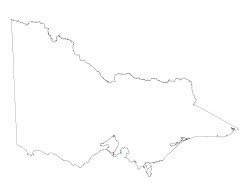7.1.3 Former swamps and lagoonal deposits (Koo-Wee-Rup, Tobin Yallock, Bass River Delta, Carrum Downs)
7. Eastern Plains (EP)
7.1 Central sunklands
| The former swamps and lagoonal deposits are the result of swamp deposits from streams and rivers including the Dandenong and Eummemmerring creeks that flowed into the former Carrum swamp, the Cardinia Creek and Bunyip River that flowed across the alluvial plains south of Pakenham into the former Koo-Wee-Rup Swamp (includes the Dalmore Swamp), and the Bass and Lang Lang Rivers which flowed into their respective alluvial plains and swamps. The Koo-Wee-Rup Swamp was contiguous with the Dalmore Swamp to form a major wetland complex with an east-west orientation. With maximum dimensions of 32 km and 14 km and at least 30,000 ha in area, this was the largest swamp in Victoria. The swamp itself developed after the last Ice Age in what had previously been an arid or semi-arid landscape. A dry climate is indicated by what appear to be wind-formed curved dunes (lunettes) on the east side of former intermittent lakes. With climate warming there was more rainfall and permanent stream flow into the Koo-Wee-Rup Swamp, with the Bunyip River being the main contributor. There was only one episode of peat formation, which persisted up to the time of drainage. The outer swamp consisted of extensive scrub dominated by Swamp Paperbark which grew on mineral soil rather than the organic peat of the inner swamp, the Swamp Paperbark requiring drainage and not tolerating permanent inundation. The core of the swamp was a very different environment, being relatively open and dominated by permanently inundated reeds and rushes growing on deep peat possibly with lake-like cells and open water bodies. Narrow sinuous sandy rises slightly above the present surface are widespread in the swamp area, both inside and outside the area of the former peat deposit. Many rises are modified by gravel extraction but they were probably mostly less than 0.5 m in height with some reaching 1 m. These sandy rises are abandoned levees and other stream deposits probably forming part of an extensive alluvial fan made by the Bunyip River during the Ice Age prior to swamp formation. |  |
The Dalmore Swamp was fed mainly by Cardinia Creek, and was known for its dense, almost impassable scrub. It occurred on mineral alluvial soil rather than the peat of the inner Koo-Wee-Rup Swamp. Before it was drained and cleared, some areas have a buried peat layer within the soil profile which is valuable in vegetable crop production due to its moisture retention, the overlying black clay preventing it from being lost. Buried peat suggests it was once part of the inner swamp but geological uplift within the local catchment of the western feeder streams reduced their catchment size and stream flow, leading to cessation of peat formation and deposition of black clay The buried peat layer is not throughout the Dalmore area, suggesting a complex geological history.
The former extensive Tobin Yallock Swamp was fed mainly by the Lang Lang River and Gum Scrub Creek and was south of the Yallock grasslands. It consisted largely of Swamp Paperbark fanning out to form a 6 km length of the north-east coast of Western Port Bay. There was no single outlet of the Lang Lang River, water issuing from the swamp via numerous rills of continually running fresh water.
The Carrum Swamp was formerly grassy wetlands and remained largely intact until about 40 years ago. Small remnants remain as protected wetland.
The general terminology for the original vegetation of the former swamps around Koo-Wee-Rup, Dalmore and Tobin Yallock is swamp scrub. Deep drains now traverse these former swamps and little of the original vegetation communities remain.
The former swamp soils around Carrum, Dalmore and the lower reaches of the Lang Lang and Bass Rivers have high clay content and crack when dry (Vertosols). Around Dalmore the soils have a naturally friable surface (self mulching) and are used for high value crops including asparagus. A large proportion of the soils around Koo-Wee-Rup still retains a thin peaty layer surface and is commonly used for potatoes and asparagus.


